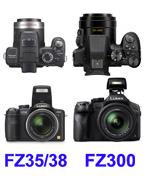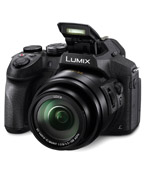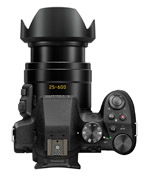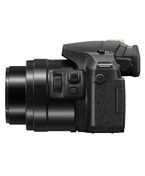External Flash
When you need to take pictures of objects and persons not too far away and under low light conditions, a flash helps. The FZ300's own flash is pretty good and powerful, and suffices at close quarters, but has inevitable limitations in angle and distance of coverage. For good party pictures and similar low light situations, a powerful and flexible external flash is often desirable.
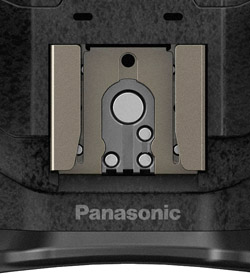 The good. The FZ300 sports the type of hot shoe common to the recent Panasonic and Olympus cameras. It allows an external flash to be attached to it, and it will work in TTL Mode, whereby the camera controls the external flash. When you press the shutter to take a picture, the unit sends a low-power light over the subject, the camera decides the exposure and, according to the ISO setting, tells the flash how strong it should emit the flash. The TTL Mode guarantees in most cases a perfect exposure with a minimum of user intervention. In a few other cases you can adjust the brightness of the picture by using the FZ300's exposure compensation, which controls either the internal or the external flash. If you prefer, of course, you can manually and separately set both camera and flash.
The good. The FZ300 sports the type of hot shoe common to the recent Panasonic and Olympus cameras. It allows an external flash to be attached to it, and it will work in TTL Mode, whereby the camera controls the external flash. When you press the shutter to take a picture, the unit sends a low-power light over the subject, the camera decides the exposure and, according to the ISO setting, tells the flash how strong it should emit the flash. The TTL Mode guarantees in most cases a perfect exposure with a minimum of user intervention. In a few other cases you can adjust the brightness of the picture by using the FZ300's exposure compensation, which controls either the internal or the external flash. If you prefer, of course, you can manually and separately set both camera and flash.
The bad. The problem arises when you try to procure an external flash for the FZ300, because this camera has difficulties with external flashes that have the traditional “universal single contact”. Users have reported serious issues with some flashes that are sometimes sold as FZ300-compatible, such as the Neewer TT560, EACHSHOT MK-320 and MeiKe MK300 MK-300. I have tested the FZ300 with the very good and affordable Soligor DG-340 AZ (a unit in perfect working order as checked with its test button) and, no matter how much I fiddle with its settings and the camera, in the majority of cases the flash fails to work when I press the camera's shutter. This happens quite at random, even when shooting repeatedly the same picture. This problem is well known to Panasonic who in the FZ300's Advanced Manual, p. 322, advises that “Some commercially available external flashes have synchro terminals with high-voltage or reversed polarity. If such flashes are used, they could cause a malfunction or hinder normal operation of the camera. If you use commercially available external flashes ... other than the ones compatible with this unit, they may not operate normally or they may be damaged. Do not use them.” Of course, you could use both the camera's own flash plus an unconnected external one (a so-called “slave flash” with a sensor cell), but in my experience this arrangement fails to work properly in quite a few situations.
The ugly. It is now apparent that, in order to have an external flash for reliable use with the FZ300, the only option is to use a “dedicated flash”, that is, a unit especially designed for the above-mentioned Olympus/Panasonic hot shoe. Unfortunately, very few such flashes are available at present, and they are all quite expensive. The obvious choice, guaranteed to work to a charm with the FZ300, is the Panasonic LUMIX FL360L: however, this flash is very expensive at €255. Even worse, there have been quite a few user complaints about this product: poor in features, cheap finishing, very short life, certainly not worth its high cost.
The one and only. The only alternative I have found is the Mecablitz range, made by Metz, a long established flash maker with very good reputation. The Mecablitz 24 is not compatible with this camera, and models 26 and 36 are not available in Europe. Therefore the choice starts at the Metz Mecablitz 44 AF-2 (*): you should buy the special model meant for “Olympus/Panasonic” cameras. This is the external flash I recommend for the FZ300: find here a review. Compared to the above-mentioned Panasonic FS360L, the Metz 44 AF-2 is more affordable (€170), more powerful, more versatile, it has an automated electrical zoom, swivel head, a LED lamp for movies and even more features, with an excellent build quality. I just bought one. As usual, there is no abridged manual for the experienced photographer, so please feel free to read and download my Metz Mecablitz 44 AF-2 Pocket Manual, especially written for Panasonic FZ300 users.
SYNC ERROR. It once happened to me that, while taking pictures in fully automated TTL mode during a wedding ceremony, suddenly the sync started to fail systematically: the flash worked, but the pictures were dark. I soon found that the shutter operated about one second after the flash, and the issue subsisted as I moved the camera's Mode dial between P, A, S and M, and tried different manual shutter speeds. Setting the flash to Manual mode worked perfectly, but sync failed again when I returned the flash to TTL mode. Clearly this was a camera glitch, as I could not find anything wrong in the flash settings (Q.MENU, Flash Mode): at this point I tried in the camera another Flash Mode, took a picture, and when I reverted to the initial “Forced Flash On” the problem was “magically” resolved. This is an unfortunate bug, showing once more that one can never entirely trust gear made—and priced—for amateur use.
The combination of FZ300 and Metz 44 AF-2 in TTL mode mostly produces excellent pictures indeed. In a few situations you will find that the light metering is less than ideal, and you can fix in the camera with Exposure Compensation (button Fn1): see our Exposure Features webpage. However, should you wish to use this flash in Manual mode, all you need is an exposure table. Again, I found nothing online, but I have calculated one and tested it too. These tables are not foolproof as they depend on subject, environment and even shutter speed: in every situation you should take some sample pictures first and then apply a correction, for example reading the table with a different ISO than the one you set in the camera. (Needless to say, you should never employ Auto ISO when using an external flash in Manual mode.)
MATHEMATICAL TRIVIA. Isn't it an interesting coincidence that the maximum distance this flash can reach with ISO 800 and full 2.8 aperture is 44 mt? This is precisely the same number used in the flash model name! No, it is not a coincidence. This flash is called "44 AF" because at ISO 100 the Guide Number (GN) is 44. So let us show that, with the flash set for Manual exposure at full 1/1 power, the camera ISO set at 800 and the subject located 44 mt away, the aperture is precisely 2.8. The formula to calculate aperture F as a function of GN and distance in mt is F = GN / mt for ISO 100. However, if we duplicate ISO, to compensate we have to close the aperture 1 EV, which is equivalent to multiplying the F value by the square root of 2, or 1.4142. If we duplicate ISO three times (in order to go from 100 to 800) we have to raise 1.4142 to the power of 3: do the maths and you will find that you get precisely 2.8! Accordingly the formula is now F = 2.8 x GN / mt = 2.8 x 44 / 44 = 2.8, "q.e.d."
Using the two flashes simultaneously. Other than using either the FZ300 own flash or the Metz 44 AF-2, you can also use both together! You place the Metz anywhere away from the camera (typically mounted on any common bracket secured to a tripod) and when you take a FZ300 picture with the camera's flash, the Metz also flashes. The more powerful Metz provides the main light, while the FZ300's own flash mitigates the shadows. This almost miraculous feat happens because (a) before the main flash the FZ300 produces a few dim pre-flashes that communicate with an external flash and (b) the Metz flash has a servo-trigger cell that detects these pre-flashes. For this to happen, however, special settings of both camera and flash are needed. In the Metz flash, things could not be easier: (1) switch it on, (2) press the “SL” blue button and (3) check that a red light blinks on front side: now the unit is ready to act as a slave flash. In the FZ300 the sequence is a bit longer: (1) select Menu-Rec-Flash-Wireless and set it to ON, (2) further below select Wireless Channel and set it to 1CH and (3) select Wireless Setup then select A Group and set it to either TTL or MANUAL. Now you can test the setting by pressing the DISP button: this produces the pre-flashes and the Metz will flash. Leave the Menu and once in Recording Mode, whenever you take a picture with the camera's flash, the Metz will also flash simultaneously. Once you have finished the slave-flash photo session, remember to go back to the FZ300's Menu-Rec-Flash-Wireless and set it to OFF: this will save battery (preventing the normally unnecessary pre-flashes) when you use the FZ300's own flash only. See a few more details on pp. 213-214 of the FZ300's Advanced Manual.
[2018 update: a reader of this webpage has kindly observed that there are nowadays a few otheralternatives, notably the Godox TT3500O, perhaps with—a few—less features from a lesser-known brand, but retailing at half the price of the Metz 44 AF-2, the Godox in unbeatable from a value-for-money perspective.]
Do you really need an external flash? Please check before you buy something that perhaps you do not need. If you only occasionally take pictures of subjects under low light conditions, remember that the FZ300's own flash can be regulated for increased output (up to 3 EV or stops more), so that with ISO 800 you can take quite decent pictures at distances as far away as 30 ft. Mind also that you should not use the flash for general views of large places such as town squares and church naves, where large differences in exposure will show between subjects located at different distances. In these situations you should use instead a tripod and long exposure.
(text written in 2016)
__________________________
(*) Please note that the 44 AF-1 is an old model lacking some of the advanced features of the AF-2.
